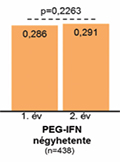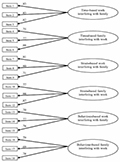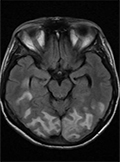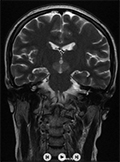The eLitMed.hu medical portal uses computer cookies for convenient operation. Detailed information can be found in the Cookie-policy.
Clinical Neuroscience - 2017;70(11-12)
Content
[Role of peginterferon-β-1a in the therapy of multiplex sclerosis]
[The subcutaneous peginterferon-b-1a is recently introduced in the therapy of relapsing-remitting multiplex sclerosis (RRMS) patients. Pegylation of IFN b-1a improved pharmacodynamic and pharmacokinetic properties, resulting in, increased biologic activity and a longer half-life. The efficacy of peginterferon-b-1a was proved by the ADVANCE study - a 2-year Phase 3, multicenter, randomized, double-blind study with a 1-year placebocontrolled period evaluating the efficacy and safety of subcutaneous peginterferon-b-1a administered every 2 or 4 weeks in patients with RRMS. Peginterferon-b-1a efficacy was maintained during the two years, with greater effects observed with every 2 week versus every 4 week dosing. Annualized relapse rate and confirmed disability progression was reduced comparing with patients on delayed treatment. Patients treated with continuous peginterferon-b-1a had fewer new or newly enlarging T2 lesions over 2 years than patients in the delayed treatment group. Adverse events were consistent with the known profiles of IFN b therapies in MS. The most commonly reported adverse events were injection site erythema, influenza-like illness. The less frequent administration is associated with fewer flu-like adverse events, which may improve patients’ compliance and adherence. Peginter-feron-b-1a could be an effective and safe treatment option for RRMS patients.]
[Alemtuzumab therapy 2017]
[Multiple sclerosis (MS) is a chronic, immune-mediated disease of the central nervous system comprising of inflammation, demyelinisation and neurodegeneration. The natural history of MS is heterogenous. Owing to the vast range and severity of the symptoms MS can cause the effect of the disease on one’s cognitive and physical status is unpredictable. According to the new, phenotype based classification two subgroups can be distinguished; relapsing-remitting (RR) and progressive MS. Relapsing-remitting MS can be further divided into active and inactive disease. The activity of the disease can be proven either clinically and/or by radiological means. A patient’s disease is considered inactive, if it fulfills the criteriae set in the “no evidence of disease activity-3” (NEDA-3) concept, meaning that no progression can be seen on the MRI scans, the patient is relapse free and there is no worsening on any disability scale. Nowadays a paradigm shift can be seen in the treatment of MS. The aim of this shift is to provide each and every patient with the most potent medication best suiting his/her illness as soon as possible. Alemtuzumab offers a great option as either a first line treatment or as escalation therapy for patients with a highly active disease. The efficacy of alemtuzumab was proven in two phase III trials (CARE-MS I, II), where it was compared to subcutaneous interferon b-1a, administered three times weekly. In both studies alemtuzumab was superior to subcutaneous interferon b-1a in terms of relapse rate reduction, in all scouted MRI parameters. In the CARE-MS II trial it was found superior in terms of progression slowing. In the studies’ first 2 years 32% and 39% of the alemtuzumab treated patients managed to achieve the NEDA-3 state (data from CARE-MS II and I respectively). At the end of the 4 year extension of both studies these numbers have increased to 60% and 55% respectively. The aim of our synopsis is to suggest neurologists an evidence based guideline, a therapeutic algorithm to be used when they give their MS patients the very best, personalised treatment, and also to appoint the recently introduced alemtuzumab to its proper place in the algorithm.]
[Change of therapeutic algorithm in sclerosis multiplex based on two case reports]
[The aim of our case reports is to demonstrate the therapeutic use and possibilities one has with alemtuzumab, should it be used either as a first or second line therapy. Our first patient's disease in the beginning seemed to be benign. It was not the case however, over several years the diesase showed high activity both radiologically and clinically, she was treated with alemtuzumab as part of an esclationbased therapeutic strategy. The second patient's disease on the other hand showed formidable activity since the very beginning both radiologically and clinically. Therefore we were facing a very disastrous prognosis on the long run, accordingly he received alemtuzumab treatment very early into his illness.]
[Tension-type headache in ulcerative colitis]
[Background and purpose - Tension-type headache is a very common disease with a high socio-economic impact as its lifetime prevalence is 30-78% in the general population. The incidence of inflammatory bowel diseases is continuously rising. Limited data are accessible on quality of life in patients with surgically treated ulcerative colitis. The aim of our study is to examine quality of life, concerning headache, among patients who had undergone surgery due to ulcerative colitis. Methods - Between 1 January 2005 and 1 March 2016, surgery was performed due to ulcerative colitis in 75 patients. During this retrospective analysis the average duration of the follow-up was 46 (1-124) months. The pre-sence of headache was evaluated by the use of Brief Illness Perception and Headache Questionnaires. Results - Among the primary headache disorders (n=27), tension-type headache occurred in 19 (70.4%) cases, and 8 (29.6%) patients had migraine (without aura). Among tension-type headache cases 17 (89.5%) patients experienced episodic form and 2 (10.5%) suffered from chronic form. Patients with headache had obtained a significantly higher score on Brief Illness Perception Questionnaire. Conclusions - According to our study tension-type headache is common among patients with ulcerative colitis. This observation raises the question whether stress plays role in the pathogenesis of both diseases, which influences and worsens considerably quality of life. Neurological examination, psychological and psychiatric guidance are worth considering in patients with ulcerative colitis.]
Validation of the Hungarian version of Carlson’s Work-Family Conflict Scale
Background and purpose - Work-family conflict has been associated with adverse individual (e.g., cardiovascular diseases, anxiety disorders), organizational (e.g., absenteeism, lower productivity), and societal outcomes (e.g., increased use of healthcare services). However, lack of standardized measurement has hindered the comparison of data across various cultures. The purpose of this study was to develop the Hungarian version of Carlson et al.’s multidimensional Work-Family Conflict Scale and establish its reliability and validity. Methods - In a sample of 557 employees (145 men and 412 women), we conducted confirmatory factor analysis to investigate the factor structure and factorial invariance of the instrument across sex and data collection points and evaluated the tool's validity by assessing relationships between its dimensions and scales measuring general, marital, and job-related stress, depressive symptomatology, vital exhaustion, functional somatic symptoms, and social support. Results - Our results showed that a six-factor model, similarly to that of the original instrument, fit the data best. Internal consistency of the six dimensions and the whole instrument was adequate. Convergent and divergent validity of the instrument and discriminant validity of the dimensions were also supported by our data. Conclusions - This study provides empirical support for the validity and reliability of the Hungarian version of the multidimensional Work-Family Conflict Scale. Deployment of this measure may allow for the generation of data that can be compared to those obtained in different cultural settings with the same instrument and hence advance our understanding of cross-cultural aspects of work-family conflict.
Nerve conduction study and gastrocnemius H reflex response in rheumatoid arthritis
Objectives - We aimed to evaluate nerve conduction studies and gastrocnemius H reflex responses in rheumatoid arthritis (RA) patients and compared to the healthy adult subjects. Materials and methods - Twenty-six RA patients and twenty-two healthy adult subjects were included in the study. The nerve conduction study (NCS) findings and bilateral gastrocnemius H reflex responses were evaluated in all the groups. Age, gender, subcutaneous nodules, joint deformities, laboratory parameters, duration of disease, anti-rheumatic drug and steroid usage were recorded. Activity of disease was assessed using a 28-joint disease activity score (DAS28).The functional status was measured using the health assessment questionnaire (HAQ), pain intensity measured using a visual analog scale (VAS). Results - The rate of electroneuromyographic (ENMG) abnormalities was 73% in RA patients. The most common diagnosis was carpal tunnel syndrome (61.4%). There were no significant correlations between ENMG findings and clinical and laboratory features evaluated. Right H reflex latencies were statistically longer in RA patients (p=0.03). According to calculated cut-off levels, there were more subjects with longer H reflex latencies in RA patients. Conclusions - In this study, entrapment neuropathies were found common as independent identity from duration and severity of disease in RA patients. For H reflex latencies, cut-off values were longer in RA patients. It may provide information about the early neuropathic involvement of long peripheral nerves in RA patients. But this findings are needed to be supported by larger population study.
Effect of maternal migraine on children’s quality of sleep
Backround and aim - Sleep disorders are common problems associated with migraine. These sleep disorders are known to have a debilitating impact on daily lives of migraine patients. The purpose of this study is to assess the effects of sleep disorders experienced by individuals suffering from migraine on their children as well as the presence of sleep disorders in their children. Materials and methods - This study included 96 mothers diagnosed with migraine and their 96 healthy children, and a control group formed of 74 healthy mothers and their children. Exclusion criteria were chronic systemic disease or central nervous system disease or a history of smoking/alcohol use for mothers, and chronic disease or regularly occurring headaches or recurrent abdominal pain for children. For maternal evaluation, the Visual Analogue Scale (VAS), Migraine Disability Assessment Scale (MIDAS), Pittsburgh Sleep Quality Index (PSQI), Beck Depression Index (BDI) and Beck Anxiety Index (BAI) were used and for the assessment of the children’s quality of sleep, the Children’s Sleep Habits Questionnaire (CSHQ) was used. The SPSS 21.0 program was employed for statistical analysis, with statistical significance set at p<0.05. Findings - The mean age of the group with migraine was 36.6±7.1 years, while that of the control group was 38.01±4.7. Mood and sleep disorders were more frequently observed in the participants with migraine (p<0.05). Sleep disorders were significantly low in children with migraineur mothers (p=0.02); and child sleep anxiety is significantly high in control group (p=0.048). Maternal BAI scores had a significant influence on their children’s quality of sleep. Discussion and conclusion - In our study, the presence of migraine-type headache in mothers was observed to have a positive effect on reducing sleep disorders in the children. Recurrent headaches of the migraineur mothers with or without sleep disorders and psychiatric comorbidities did not influence the quality of sleep in their children directly, but the sleep anxiety of the children may have had an impact on it.
Posterior reversible encephalopathy syndrome as an initial manifestation of systemic lupus erythematosus
Posterior reversible encephalopathy syndrome (PRES) is a disorder which is diagnosed with its characteristic clinical and radiological findings, typically resolves with treatment. The prevalence of PRES in systemic lupus erythematosus (SLE) patients is not exactly known. A systemic disorder frequently appears as a presenting symptom in SLE. However, in rare cases, the disease starts with a neurological manifestation. Here we report a 35-year-old woman presenting with a headache and blurred vision. She had neurologic symptoms and cerebral lesions on magnetic resonance imaging (MRI) suggesting PRES. The patient was diagnosed with SLE during the etiological investigation of PRES. In this article, we aimed to emphasize that PRES as an initial presentation of SLE.
A case with reversible neurotoxicity induced by metronidazole
Background - Metronidazole is a synthetic antibiotic, which has been commonly used for protozoal and anaerobic infections. It rarely causes dose - and duration - unrelated reversible neurotoxicity. It can induce hyperintense T2/FLAIR MRI lesions in several areas of the brain. Although the clinical status is catastrophic, it is completely reversible after discontinuation of the medicine. Case report - 36-year-old female patient who had recent brain abscess history was under treatment of metronidazole for 40 days. She admitted to Emergency Department with newly onset myalgia, nausea, vomiting, blurred vision and cerebellar signs. She had nystagmus in all directions of gaze, ataxia and incompetence in tandem walk. Bilateral hyperintense lesions in splenium of corpus callosum, mesencephalon and dentate nuclei were detected in T2/FLAIR MRI. Although lumbar puncture analysis was normal, her lesions were thought to be related to activation of the brain abscess and metronidazole was started to be given by intravenous way instead of oral. As lesions got bigger and clinical status got worse, metronidazole was stopped. After discontinuation of metronidazole, we detected a dramatic improvement in patient’s clinical status and MRI lesions reduced. Conclusion - Although metronidazole induced neurotoxicity is a very rare complication of the treatment, clinicians should be aware of this entity because its adverse effects are completely reversible after discontinuation of the treatment.
1.
Clinical Neuroscience
Is there any difference in mortality rates of atrial fibrillation detected before or after ischemic stroke?2.
Clinical Neuroscience
Factors influencing the level of stigma in Parkinson’s disease in western Turkey3.
Clinical Neuroscience
Neuropathic pain and mood disorders in earthquake survivors with peripheral nerve injuries4.
Journal of Nursing Theory and Practice
[Correlations of Sarcopenia, Frailty, Falls and Social Isolation – A Literature Review in the Light of Swedish Statistics]5.
Clinical Neuroscience
[Comparison of pain intensity measurements among patients with low-back pain]1.
2.
Clinical Neuroscience Proceedings
[A Magyar Stroke Társaság XVIII. Kongresszusa és a Magyar Neuroszonológiai Társaság XV. Konferenciája. Absztraktfüzet]3.
4.
Journal of Nursing Theory and Practice
[A selection of the entries submitted to the literary contest "Honorable mission: the joys and challenges of our profession" ]5.
Journal of Nursing Theory and Practice
[End of Life and Palliative Care of Newborns in the Nursing Context]










